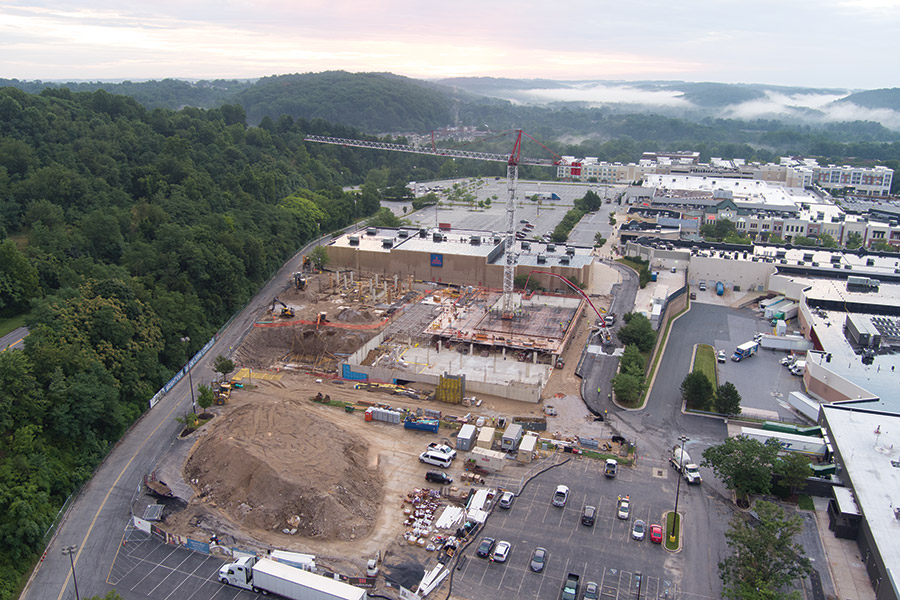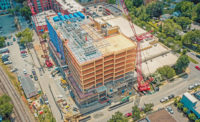ENR MidAtlantic 2024 Contractor of the Year: Maryland Firm Optimizes Opportunity

Harkins recently finished the Ruby at Somerset in Baltimore. Named after jazz vocalist Ruby Glover, the mixed-income community has 72 apartments.
Photo courtesy Harkins Builders
Successfully implementing strategic growth has become something of a tradition for Harkins Builders. With each office the Columbia, Md.-based contractor has opened in recent years, new projects and a sizable share of market activity have soon followed.
Last year was no different. Harkins’ leaders credit newly opened offices in Richmond and Raleigh-Durham for helping to fuel $725 million in national revenue. Harkins’ $625 million in regional revenue vaulted it to No. 14 on ENR MidAtlantic’s Top Contractors ranking, a 68% increase from the $371.64 million in revenue the firm reported for the previous year. The company notes that MidAtlantic region projects—managed out of Columbia, Richmond and Easton, Pa.—account for 85% of its work.
Targeting areas where multifamily housing is in high demand has enabled Harkins Builders to capitalize on its long-standing experience and reputation in that sector. For example, the Richmond office recently completed the first phase of Kindlewood, a 106-unit affordable housing project in Charlottesville that was designed to energy-efficient, Passive House standards.
Ben Nichols, Harkins president and CEO, notes that along with the Richmond area’s prospects for continued growth, adding an office there to serve that market and the Tidewater area fills a geographic “hole” between Harkins’ Carolina locations and its offices to the north.
Because the offices are located approximately the same distance from each other, he says, “It sets up a situation where each office can support itself and share resources.”
Nichols also takes particular pride in the recent efforts of the company’s government contracting team, which have yielded several major new contracts for multiple federal agencies across the region.
“We’ve been doing work in that arena for well over three decades, but the last few years have been nothing short of fantastic,” says Nichols. “It’s been really been fun to see them grow.”
Omar Black, senior vice president, notes that Harkins’ strong reputation based on nearly 60 years of construction experience has helped the company gain an early foothold in these new markets. He points to the role the company’s preconstruction services has played in helping owners adapt project budget strategies to the post-pandemic market influences.
“Some of the projects [were] delayed or extended by months or even years,” he says. “Having the preconstruction team be available for the life cycle of the project helped us keep our touchpoints on trends and costs. That helped separate us from the competition.”

Located in Cockeysville, Md., Brightview Hunt Valley is a 178-unit senior living community. The seven-story building will feature two stories of structured parking within a concrete podium topped by five-and-a-half stories of residential and amenity spaces.
Photo courtesy Harkins Builders
Employee Ownership Advantages
Another differentiator, Nichols says, is being entirely employee-owned since 2014.
“That helps drive our culture,” he explains. “All our team owners are invested in the company and are pushing in the same direction at the same time to help solve challenges.”
In addition, Nichols considers full employee ownership “a great accountability tool for our leadership team to be transparent with what’s going on in the company financially and operationally as well as strategically.”
Harkins also has fostered innovation among its employees through its Innovative Capital Reinvestment (ICR) program, initiated as part of the company’s most recent strategic plan. Likening the program to the popular “Shark Tank” reality television show, Nichols says ICR encourages employees to pitch ideas for improving processes and customer relations, enhancing corporate culture, reducing project costs and creating efficiencies.
“They're a good, thoughtful, trusted partner at all stages of construction.”
—Doug Dollenberg, President & CEO, Brightview Senior Living
According to the company, the ICR has invested nearly $200,000 in nine projects, including TeamBuilder, a web-based workforce planning application that the company says allows its operations personnel to match available staffing resources to project needs.
Harkins’ extensive investments in its people have benefited the company and its clients, according to Doug Dollenberg, president and CEO of Brightview Senior Living, an organization that has worked with Harkins for nearly a half-century.
“They’re a good, thoughtful, trusted partner at all stages of construction,” Dollenberg says. “In preconstruction, we rely on their advice and guidance, especially if there are ways to do things differently. At the construction stage, they’re knowledgeable and reliable and get the job done on time, which is huge.”
And in the event an issue arises years down the road, Dollenberg adds, Harkins is still there to help. “They figure out what is right for the client and the partnership,” he says.

When complete, Phase II of the Perkins Homes project will bring more than 150 mixed-income rental units to East Baltimore.
Photo by Carlos Zuluaga, courtesy Harkins Builders
Harkins Builders’ Major MidAtlantic Projects Include:
Twin Rivers, Columbia, Md.
Harkins helped long-term client Enterprise Community Development achieve a major milestone of 1 million homes with this 153-unit modern and sustainable mixed-income community. Twin Rivers offers a variety of amenities, including a leasing office, management office, business center, fitness center, homework room, mail room, dog park, playground and cast-in-place below-grade parking for residents.
The Ruby at Somerset, Baltimore
Named after famed jazz vocalist Ruby Glover, the mixed-income community is part of Baltimore’s Perkins Somerset Oldtown Transformation Plan. The 72-unit apartment building’s structure combines concrete and wood frame construction with a vibrant exterior design blending brick, fiber cement siding and Nichiha Illumination panels.
Naval Facilities Systems Engineering Command MidAtlantic, Norfolk, Va.
Harkins Builders is one of eight contractors selected for a five-year, $950-million contract to support large construction projects in the Hampton Roads area. This multiple-award, indefinite-delivery/indefinite-quantity contract is expected to include projects such as administrative offices, communications infrastructure, dormitories, industrial buildings, medical clinics, training ranges and warehouses over a five-year period.
Tactics for Tomorrow
The current robust MidAtlantic construction market would seem to hold great promise for Harkins Builders to sustain its success.
“The opportunities are there,” says Black, adding that the biggest challenges are financial factors, such as interest rate levels and lending institutions’ equity requirements for developers that have delayed some project starts. On the other side of the coin, he says, “there are a lot of projects in the government world and a big need for affordable housing. We’re also looking to expand into higher education and lab work.”
Coming off what he calls a “hypergrowth pattern,” Nichols says the company is focused on maintaining its strong revenue performance and continuing to train and develop people inside the organization.
“We have all the same challenges that every other contractor out there is facing,” he says, from recruiting and retaining engineering and trade talent to adapting to post-pandemic supply chain realities.
“I feel like we’ve gotten some stability, to the point where now everybody knows what to plan for,” he says. “Even though we know it’s taking longer for things to get to us, we’re doing a better job as an industry in planning for it.”
Black adds that the present environment has also heightened the importance of partnerships with owners, design teams and subcontractors.
“We are trying our absolute best to create a culture where our younger employees are pulling information from our more seasoned staff.”
—Ben Nichols, President & CEO, Harkins
“It’s being better communicators and showing you’re doing your due diligence in reaching out to the trade partner market in terms of what you’ll build your budget with,” he says. “We’ve also gotten better at finding ways to build budgets to meet the growing number of requirements for things such as energy use and small-business participation.”
These are just some of the issues under discussion as Harkins begins development of its next five-year strategic plan, which will carry the company through the end of the decade. The broad-based effort is affording all 350 employees an opportunity to provide input on priorities and contribute ideas.
The process has already yielded valuable insights, says Nichols. He recalls sitting in on a small group discussion on Harkins’ middle management structure, a level where, in any organization, communication breakdowns frequently occur.
“It was a fun discussion trying to figure out how we can best organize the company to allow for the most efficiencies and to be great communicators as an organization,” he says.
Other areas being explored include future geographic and sector expansion, applications of emerging jobsite technology and improving quality of life for employees, both on and off the job.
“Construction has a high burnout and suicide rate, and those stresses were more pronounced during the pandemic,” Black says, “We want to make sure we’re providing a great work environment that encourages a good work-life balance and provide employees with opportunities for professional growth that they won’t find at our competitors.”
That includes fostering an environment of continual learning, particularly with so many longtime, experienced employees reaching retirement age.
“We’re trying our absolute best to create a culture where our younger employees are pulling information from our more seasoned staff,” Nichols says, “and we want those experienced employees constantly thinking about what they can teach somebody every single day.”



